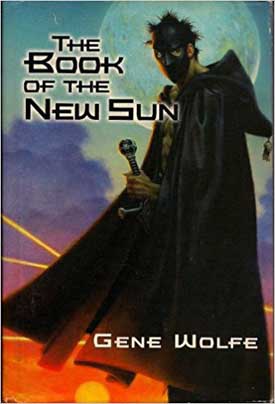 Science fiction, like any other genre, has its landmarks, those works that stand above their cohort and may, all else being equal, stand above most works from other genres as well (and I include so-called “mainstream” literature among genres). Gene Wolfe’s The Book of the New Sun is widely recognized as being one of these: a work that established a new paradigm for science fiction as a literary form and may rank as one of the great works of American literature in general.
Science fiction, like any other genre, has its landmarks, those works that stand above their cohort and may, all else being equal, stand above most works from other genres as well (and I include so-called “mainstream” literature among genres). Gene Wolfe’s The Book of the New Sun is widely recognized as being one of these: a work that established a new paradigm for science fiction as a literary form and may rank as one of the great works of American literature in general.
In brief, the four volumes of The Book of the New Sun tell of the rise of Severian, whom we see first as an apprentice torturer, soon exiled from his guild for showing compassion toward a client. He begins a journey to the North, first on an assignment, then as what amounts to a fugitive, and eventually becomes the Autarch of the Confederation, in theory, at least, the ruler of the people of Urth (as it is called). A coda, The Urth of the New Sun, is Severian’s account of his journey to be tested and, if successful, to redeem Urth.
Severian’s Urth is an ancient planet circling a sun that has grown old and fitful, an insular place where science has become a kind of magic. It is a world populated by people, not-quite people, monsters (including some who may be people on other worlds), and a raft of phenomena for which Severian offers no explanation. The family resemblance to Jack Vance’s Dying Earth stories is striking.
There have been, at this point, a number of studies of The Book of the New Sun, from critical essays to dissertations to full-blown books, examining Wolfe’s tactics and devices. I’m not going to approach that area because a) it’s been done, and b) it’s much more interesting for you, I suspect, to know what it’s like to read these books.
There is a signal, almost definitive fact about reading Gene Wolfe: he messes with your head. He does it regularly and with great glee. Be warned.
First off, Severian narrates the entire series. He claims a perfect memory, but the reader would be well-advised to keep one significant fact in mind when reading this or anything else by Gene Wolfe: Wolfe’s narrators are not reliable. Sometimes they are naïve, sometimes duplicitous, sometimes just not very bright. Severian is no different: he doesn’t always tell the truth.
Perhaps, before you realize that Severian is lying to you (not consistently — just when it suits him), you will be captivated, and then puzzled, by Wolfe’s language. He is at pains to explain, in an appendix that follows The Shadow of the Torturer, that this story is a translation of a book “originally composed in a tongue that has not yet achieved existence.” He goes on to point out that, although it might have been easier to invent words, he has not done so: these are all real words, or words developed from real words. The one thing that is missing is a glossary: meanings must be derived from context. And so as you read along, you develop a rich framework of meanings, potential meanings, associations, connotations, none of which have any particular foundation.
It’s as though someone had managed to record someone else’s fever dream, a fundamentally surreal story that maintains its distance, even though the telling is as concrete as possible. Some critics have wondered if Wolfe didn’t sacrifice substance for style, but I have to say I see no evidence of it — quite the opposite, in fact. There are some fairly heavy-duty themes flying around these books, not the least of which is the idea of the protagonist as a sacrifice. One commentator attempted to conjoin Jesus and Apollo and come up with Severian, although I tend to see Severian as much more of a Dionysian figure, no matter his ostensible dispassion. There is also the fact that Wolfe, like any other good postmodern writer, has made style into substance, and done it very well: the elements of the story — the diction, the unreliability of Severian, the events themselves — raise questions on the nature of reality and how we experience it.
This is a mere sketch of The Book of the New Sun, quite deservedly considered a masterpiece. Entertaining, most definitely, and substantial on several levels, this is one that I think has helped lay the foundations under what a number of younger writers are now attempting to do, with varying degrees of success. Read it — you might as well be present at the creation.
Shadow/Claw (The Shadow of the Torturer [1980], The Claw of the Conciliator [1981]) (Orb Books)
Sword/Citadel (The Sword of the Lictor [1981], The Citadel of the Autarch [1982]) (Orb Books)
The Urth of the New Sun (Orb Books, 1987)
